This article does not cite any sources .(October 2017) (Learn how and when to remove this template message) |
Carr Lowrey Glass Company (1889–2003) was a manufacturer of glass bottles.
This article does not cite any sources .(October 2017) (Learn how and when to remove this template message) |
Carr Lowrey Glass Company (1889–2003) was a manufacturer of glass bottles.
Carr Lowrey Glass Company founded in Baltimore, Maryland in 1889. Located on the Middle Branch of the Patapsco River in a neighborhood named Westport, Samuel Carr and William Lowrey established their company to create glass bottles for the pharmaceutical and perfume industries. As seen from the locally famous Hanover Street Bridge, just west of Fort McHenry, you could see the towering smoke stacks and piles of discarded blue glass the factory.
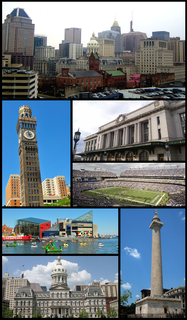
Baltimore is an independent city in the state of Maryland within the United States. Baltimore was established by the Constitution of Maryland as an independent city in 1729. With a population of 611,648 in 2017, Baltimore is the largest such independent city in the United States. As of 2017, the population of the Baltimore metropolitan area was estimated to be just under 2.808 million, making it the 20th largest metropolitan area in the country. Baltimore is located about 40 miles (60 km) northeast of Washington, D.C., making it a principal city in the Washington-Baltimore combined statistical area (CSA), the fourth-largest CSA in the nation, with a calculated 2017 population of 9,764,315.

Maryland is a state in the Mid-Atlantic region of the United States, bordering Virginia, West Virginia, and the District of Columbia to its south and west; Pennsylvania to its north; and Delaware to its east. The state's largest city is Baltimore, and its capital is Annapolis. Among its occasional nicknames are Old Line State, the Free State, and the Chesapeake Bay State. It is named after the English queen Henrietta Maria, known in England as Queen Mary.
The Middle Branch River is a 35.1-mile-long (56.5 km) tributary of the Muskegon River in Osceola County, Michigan, in the United States.
Their company grew over the years as they were one of the first companies to utilize an "IS Machine," a machine that had individual sections that were timed to automatically blow and move the bottles to a conveyor system.

A conveyor system is a common piece of mechanical handling equipment that moves materials from one location to another. Conveyors are especially useful in applications involving the transportation of heavy or bulky materials. Conveyor systems allow quick and efficient transportation for a wide variety of materials, which make them very popular in the material handling and packaging industries. They also have popular consumer applications, as they are often found in supermarkets and airports, constituting the final leg of item/ bag delivery to customers. Many kinds of conveying systems are available and are used according to the various needs of different industries. There are chain conveyors as well. Chain conveyors consist of enclosed tracks, I-Beam, towline, power & free, and hand pushed trolleys.
In 1944, they were acquired by the Anchor-Hocking Glass Company. During this time, the company experienced major expansion. Carr-Lowrey was one of the producers of the famous Avon bottles that were shaped like cars, planes, animals, and also white glass shampoo bottles for Head & Shoulders, as well as facial cream bottles for Procter & Gamble.

Anchor Hocking Company is a manufacturer of glassware. The Hocking Glass Company was founded in 1905 by Isaac Jacob (Ike) Collins in Lancaster, Ohio, and named after the Hocking River.
Avon Products, Inc, known as Avon, founded by David H. McConnell in 1886 is a direct selling company in beauty, household, and personal care categories. Avon had annual sales of $5.5 billion worldwide in 2018

Head & Shoulders (H&S) is an American brand of anti dandruff and non dandruff shampoo produced by parent company Procter & Gamble that was introduced in 1961.
As the global economy moved toward plastic bottles after World War II, the company's began to see fewer orders. To make matters worse, the company's glorified 6-Tank was shut down during a strike and was never restarted. Ownership of the company changed hands several times as the company struggled to find its niche. Moreover, Carr Lowrey had formidable competition in New Jersey with Wheaton Glass and from foreign companies such as St. Gobain in France and Rocco Bormioli in Italy. St. Gobain eventually opened a plant in Georgia, which spelled doom for Carr-Lowrey.

World War II, also known as the Second World War, was a global war that lasted from 1939 to 1945. The vast majority of the world's countries—including all the great powers—eventually formed two opposing military alliances: the Allies and the Axis. A state of total war emerged, directly involving more than 100 million people from over 30 countries. The major participants threw their entire economic, industrial, and scientific capabilities behind the war effort, blurring the distinction between civilian and military resources. World War II was the deadliest conflict in human history, marked by 50 to 85 million fatalities, most of whom were civilians in the Soviet Union and China. It included massacres, the genocide of the Holocaust, strategic bombing, premeditated death from starvation and disease, and the only use of nuclear weapons in war.

Wheaton Industries was a long-standing famous manufacturer of glassware and ceramics products in Millville, New Jersey, USA. A spin-off of the original firm adopted the name in 2006.

Compagnie de Saint-Gobain S.A. is a French multinational corporation, founded in 1665 in Paris and headquartered on the outskirts of Paris, at La Défense and in Courbevoie. Originally a mirror manufacturer, it now also produces a variety of construction and high-performance materials. The company is a component of the Euro Stoxx 50 stock market index.
The Abell Foundation, a local Baltimore philanthropy, loaned Carr-Lowrey money in an effort to keep an historic business in Baltimore alive. Unfortunately, Carr-Lowrey was never able to remain profitable and eventually closed its doors in 2003.
The image of Baltimore as a rusting industrial city seems to be fading. The city's downtown is now vibrant with activity from financial companies and bio-technology from nearby Johns Hopkins University and the University of Maryland at Baltimore. With this rebirth of the city, the waterfront property in and around town has become desired property for developers. The land once occupied by Carr-Lowrey Glass Company is now slated for waterfront housing. With Baltimore's Light Rail running right next to the property, a nearby exit to I-95, and a main road straight into downtown, the former Carr-Lowrey Glass Company site is considered by many an ideal place for residential and commercial development.

The Johns Hopkins University is a private research university in Baltimore, Maryland. Founded in 1876, the university was named for its first benefactor, the American entrepreneur, abolitionist, and philanthropist Johns Hopkins. His $7 million bequest —of which half financed the establishment of Johns Hopkins Hospital—was the largest philanthropic gift in the history of the United States up to that time. Daniel Coit Gilman, who was inaugurated as the institution's first president on February 22, 1876, led the university to revolutionize higher education in the U.S. by integrating teaching and research. Adopting the concept of a graduate school from Germany's ancient Heidelberg University, Johns Hopkins University is considered the first research university in the United States. Over the course of several decades, the university has led all U.S. universities in annual research and development expenditures. In fiscal year 2016, Johns Hopkins spent nearly $2.5 billion on research.
Interstate 95 (I-95) in Maryland is a major highway that runs 109.01 miles (175.43 km) diagonally from northeast to southwest, from Maryland's border with Delaware, to the Woodrow Wilson Bridge, briefly entering the District of Columbia before reaching Virginia. The route is one of the most heavily traveled Interstate Highways in Maryland, especially between Baltimore and Washington, D.C., despite alternate routes along the corridor, such as the Baltimore-Washington Parkway, U.S. 1, and U.S. Route 29. Portions of the highway are tolled.
In 2004, Patrick Turner, owner of Turner Development Company, purchased the property once occupied by Carr Lowrey. He soon purchased the electric generating plant next door that was owned by Baltimore Gas & Electric.
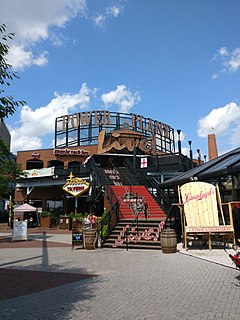
Power Plant Live! is a collection of bars, restaurants and other businesses in the Inner Harbor section of downtown Baltimore, Maryland. It was developed by The Cordish Companies and opened in phases during 2001, 2002, and 2003. The entertainment complex gets its name from the nearby "Power Plant" building, three blocks south on municipal Pier 4 on East Pratt Street facing the Inner Harbor, which was also later re-developed by Cordish.
Deer Park is a brand of bottled water from the Nestlé company, produced and marketed primarily in the Mid-Atlantic region of the United States.
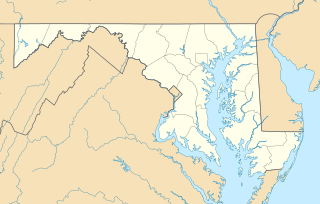
Sparrow's Point is an unincorporated community in Baltimore County, Maryland, adjacent to Dundalk. Named for Thomas Sparrow, landowner, it was the site of a very large industrial complex owned by Bethlehem Steel, known for steelmaking and shipbuilding.
Westport is a neighborhood in south Baltimore, Maryland. Westport is a majority African-American neighborhood that has struggled with crime, housing abandonment, and unemployment in the past decade. The neighborhood is bordered by the Middle Branch of the Patapsco River on the east, the city neighborhoods of Cherry Hill, Brooklyn and the southwestern Baltimore County community of Lansdowne to the southwest, Hollins Ferry Road and the Mount Winans and Lakeland neighborhoods to the west, and Interstate 95 to the north, along with the South Baltimore communities of Federal Hill and Otterbein. The Baltimore-Washington Parkway runs through the middle of Westport and intersects with Interstate 95, the main East Coast super-highway, north to south, Maine to Florida.

Emerson Tower often referenced as Emerson Bromo-Seltzer Tower or the Bromo Tower is a 15-story, landmark 88 m (289 ft) clock tower erected in 1907-1911 at 21 South Eutaw Street, at the northeast corner of Eutaw and West Lombard Streets in downtown Baltimore, Maryland. It was the tallest building in the city from 1911 to 1923, until supplanted by the Citizens National Bank building [later First National Bank of Maryland, then occupied by MECU - Municipal Employees Credit Union] at the southeast corner of Light and Redwood (German) Streets. It was designed by well-known local architect Joseph Evans Sperry (1854-1930) for Bromo-Seltzer inventor "Captain" Isaac E. Emerson (1859-1931).

Transamerica Tower and originally built as the "USF&G Building", serving as headquarters of the United States Fidelity and Guarantee Company, a specialized insurance company founded in Baltimore in 1896, and relocated here from its former complex of three adjoining early 20th Century masonry structures at the southwest corner of South Calvert and Redwood Streets. Later occupied by and known as the Legg-Mason Building, it is a 40-story, 161 m (528 ft) skyscraper completed in 1973 in downtown Baltimore, Maryland at 100 Light Street on the city block bounded by South Charles, East Lombard, Light and East Pratt Streets, facing the former "The Basin" of the Helen Delich Bentley Port of Baltimore on the Northwest Branch of the Patapsco River and the newly iconic Inner Harbor downtown business waterfront redevelopment of the 1970s-80's era.
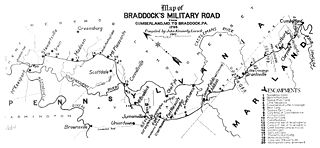
Cumberland, Maryland is named after the son of King George II, Prince William, the Duke of Cumberland. It is built on the site of the old Fort Cumberland, a launch pad for British General Edward Braddock's ill-fated attack on the stronghold of Fort Duquesne during the French and Indian War.
St. Paul Street and Calvert Street are a one-way pair of streets in Downtown Baltimore and areas north. The streets, which are part of Maryland Route 2, are two of Baltimore's best-known streets in the downtown area.

Mount Clare, also known as Mount Clare Mansion and generally known today as the Mount Clare Museum House, is the oldest Colonial-era structure in the City of Baltimore, Maryland, U.S.A. The Georgian style of architecture plantation house exhibits a somewhat altered five-part plan. It was built on a Carroll family plantation beginning in 1763 by barrister Charles Carroll the Barrister, (1723–1783), a descendant of the last Gaelic Lords of Éile in Ireland and a distant relative of the much better-known Charles Carroll of Carrollton, (1737–1832), longest living signer of the Declaration of Independence and the richest man in America in his later years, also the layer of the First Stone of the new Baltimore and Ohio Railroad, just a short distance away in 1828.

Inner Harbor East, now more recently referred to more commonly as simply as Harbor East, is a relatively new mixed-use development project in Baltimore, Maryland, United States along the northern shoreline of the Northwest Branch of the Patapsco River, which is the Baltimore Harbor, and its Inner Harbor. Major tenants of Harbor East include the Baltimore Marriott Waterfront Hotel on Aliceanna Street, between the Waterfront Promenade on the west and to the east is the President Street Boulevard and the Katyn Forest Massacre Memorial (monument) in the International Drive circle at the south end.. Also, the new Legg Mason Tower, in which the famous financial services firm moved from the central downtown is located across the street. A Four Seasons Hotel opened in November 2011.

Lion Brothers Company Building is a historic factory located at 875 Hollins St, Baltimore, Maryland 21201. It is a multi-level building that once housed the operations of the Lion Brothers embroidery company. The original building was constructed in 1885 and expanded several times over the subsequent 75 years. In 1958 the Lion Brothers moved their production facility to another location allowing Marcus & Farber and Globe Screen Printing to move in. The building has been vacant since 2002 and Cross Street Partners has plans to restore the building as a local innovation center.

The Washington, Baltimore and Annapolis Electric Railway (WB&A) was an American railroad of central Maryland and Washington, D.C., built in the 19th and 20th century. The WB&A absorbed two older railroads, the Annapolis and Elk Ridge Railroad and the Baltimore & Annapolis Short Line, and added its own electric streetcar line between Baltimore and Washington. It was built by a group of Cleveland, Ohio, electric railway entrepreneurs to serve as a high-speed, showpiece line using the most advanced technology of the time. It served Washington, Baltimore, and Annapolis, Maryland, for 27 years before the Great Depression and the rise of the automobile forced an end to passenger service in 1935. Only the Baltimore & Annapolis portion continued to operate. Today, parts of the right-of-way are used for light rail, rail trails and roads.

Ardagh Group is a Luxembourg-based producer of glass and metal products that has "grown in the past two decades into one of the world’s largest metal and glass packaging companies".
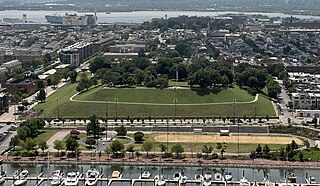
Federal Hill Park is a 10.3 acres park located in Baltimore, Maryland on the south shore of the Inner Harbor. The park is a signature Baltimore landmark and offers visitors some of the most noted views in the city often photographed looking north to the downtown skyline of skyscrapers across the Inner Harbor of the Northwest Branch of the Patapsco River / Baltimore Harbor. The Federal Hill surrounding neighborhood to the west and south is named for the prominent hill and is also known as old South Baltimore. The now graded grass lawn hill and park, was originally a jagged cliffs and bluffs of red clay which was mined in the 18th and 19th centuries after being first sighted and described by Captain John Smith of England on his voyages of exploration of the Chesapeake Bay from the first English colony at Jamestown, Virginia in 1608. The noted famous site today is bounded by Francis Scott Key Highway along the waterfront to the north, Battery Avenue to the west, Warren Avenue to the south, and Covington Street to the east. Baltimore city acquired the hill as public property in 1880 after it was used and fortified as a fort with heavy artillery by the Union Army during the American Civil War (1861-1865). It was established then as a city park operated and maintained by the city Department of Recreation and Parks.

The "Henry Fite House", located on West Baltimore Street, between South Sharp and North Liberty Streets, in Baltimore, Maryland, was the meeting site of the Second Continental Congress from December 20, 1776 until February 22, 1777. Built as a tavern around 1770 in Georgian architectural style in red brick with white wood trim in by Henry Fite (1722–1789), the building later became known as "Congress Hall" during its brief use by Congress six years later, and later following the American Revolutionary War in local history as "Old Congress Hall". It was destroyed 127 years later by the Great Baltimore Fire on Sunday and Monday, February 7–8, 1904, which started a block to the southwest at North Liberty and German Streets at the John E. Hurst Company building and swept north to Fayette Street and finally to the east to the Jones Falls, burning most of the downtown central business district and waterfront, of which only a few modern "fire-proof" skyscrapers recently built, though with burned interiors, had enough steel structural support left to save, rebuild and restore later.

Patterson Park is a neighborhood in Baltimore, Maryland, United States. The neighborhood is located in the southeast section of Baltimore city and borders the 137 acre park of the same name on the north and east sides. Patterson Park is traditionally centered on the intersection of Baltimore Street and Linwood Avenue and until the formation of Patterson Park Neighborhood Association in 1986 was referred to as the Baltimore-Linwood Neighborhood. The original borders of Patterson Park neighborhood were Pratt Street to the south, Fayette Street to the north, Milton Street to the west and Clinton Street to the east, but in 2011 the Patterson Park Neighborhood Association voted to expand the northern border to Orleans Street between Milton and Curley Street.
Verallia North America formerly the North American division of Verallia, is a glass packaging brand of the multinational company Ardagh Group. It produces more than nine billion glass bottles and jars from thirteen plants located throughout the United States and is headquartered in Muncie, Indiana.
The following is a timeline of the history of the city of Baltimore, Maryland, United States